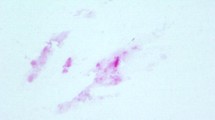Abstract
A case report and review of literature is reported of a rare case of fungal keratitis from eastern India. A 32-year-old woman with a history of vegetative trauma presented with keratitis in left eye. Microbiological examination of corneal scraping showed refractile hyphae with aseptate branching filaments and black pigmented colonies on multiple solid agar medium. Organism was identified from culture using D1/D2 region of LSU (Large Sub Unit: 28S rDNA)-based molecular technique. PCR amplified a band with a sequence that was 100 % homologous with Lasiodiplodia theobromae. The organism was susceptible to amphotericin B and voriconazole and demonstrated resistance to itraconazole and fluconazole. A therapeutic keratoplasty was performed following non-responsiveness to initial topical voriconazole (2 %) therapy. Recurrence in graft was controlled with topical voriconazole and intracameral amphotericin B. However, the graft failed at the end of 3 months. L. theobromae is a rare cause of fungal keratitis. Management of these cases is difficult, often involving surgical procedures.


Similar content being viewed by others
References
Puttanna ST. Mycotic infections of the cornea. J All-India Ophthalmol Soc. 1967;15:11–8.
Laverde S, Moncada LH, Restrepo A, Vera CL. Mycotic keratitis, 5 boxes caused by unusual fungi. Sabouraudia. 1973;11:119–23.
Valenton MJ, Rinaldi MG, Butler EE. A corneal abscess due to the fungus Botryodiplodia theobromae. Can J Ophthalmol. 1975;10:416–8.
Rebell G, Forster RK. Lasiodiplodia theobromae as a cause of keratomycoses. Sabouraudia. 1976;14:155–70.
Liesegang TJ, Forster RK. Spectrum of microbial keratitis in South Florida. Am J Ophthalmol. 1980;90:38–47.
Thomas PA. Current perspectives on ophthalmic mycoses. Clin Microbiol Rev. 2003;16:730–97.
Srinivasan M, Gonzales CA, George C, et al. Epidemiology and aetiological diagnosis of corneal ulceration in Madurai, South India. Br J Ophthalmol. 1997;81:965–71.
Thew MR, Todd B. Fungal keratitis in far north Queensland, Australia. Clin Exp Ophthalmol. 2008;36:721–4.
Slomovic AR, Forster RK, Gelender H. Lasiodiplodia theobromae panophthalmitis. Can J Ophthalmol. 1985;20:225–8.
Borderie VM, Bourcier TM, Poirot JL, Baudrimont M, Prudhomme de Saint-Maur P, Laroche L. Endophthalmitis after Lasiodiplodia theobromae corneal abscess. Graefes Arch Clin Exp Ophthalmol. 1997;235:259–61.
Donnio A, Desbois N, Boiron P, Théodose R, Mouniee D, Thoumazet F, Merle H. Mycotic keratitis and endophthalmitis caused by unusual fungi: Lasiodiplodia theobromae. J Fr Ophtalmol. 2006;29:e4.
Radford AS, Johnson M, Warnock WD. In vitro studies of Activity of Voriconazole (UK-109,496), a new Triazole antifungal agent, against emerging and less-common mold pathogens. Antimicrob Agents Chemother. 1997;4:841–3.
Gonawardena SA, Ranasinghe KP, Arseculeratne SN, Seimon CR, Ajello L. Survey of mycotic and bacterial keratitis in Sri Lanka. Mycopathologia. 1994;127:77–81.
Rosa RH, Miller D, Alfonso EC. The changing spectrum of fungal keratitis in South Florida. Ophthalmology. 1994;101:1005–13.
Dunlop AA, Wright ED, Howlader SA, Nasrul I, Husain R, McClellan K, et al. Suppurative corneal ulceration in Bangladesh: a study of 142 boxes, examining the microbiological diagnosis, clinical and epidemiological features of bacterial and fungal keratitis. Aust NZ J Ophthalmol. 1994;22:105–10.
Hagan M, Wright E, Newman M, Dolin P, Johnson G. Causes of suppurative keratitis in Ghana. Br J Ophthalmol. 1995;79:1024–8.
Garg P, Gopinathan U, Choudhary K, Rao GN. Keratomycosis: clinical and microbiologic experience with dematiaceous fungi. Ophthalmology. 2000;107:574–80.
Gopinathan U, Garg P, Fernandes M, Sharma S, Athmanathan S, Rao GN. The Epidemiological features and laboratory results of fungal keratitis. A 10-year review at a referral eye care center in South India. Cornea. 2002;21:555–9.
Author information
Authors and Affiliations
Corresponding author
Rights and permissions
About this article
Cite this article
Saha, S., Sengupta, J., Banerjee, D. et al. Lasiodiplodia theobromae Keratitis: A Case Report and Review of Literature. Mycopathologia 174, 335–339 (2012). https://doi.org/10.1007/s11046-012-9546-7
Received:
Accepted:
Published:
Issue Date:
DOI: https://doi.org/10.1007/s11046-012-9546-7




